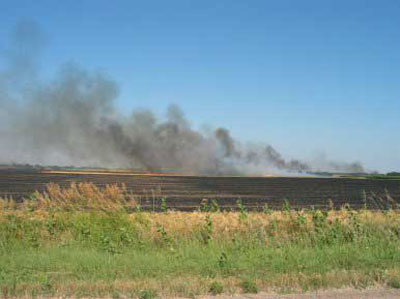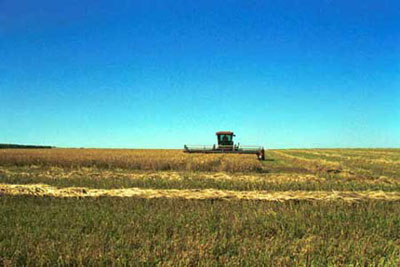Why Do Farmers Burn?
The majority of farmers do not burn. They prefer to handle straw in other ways, for example, by tilling it into the soil, and by chopping and spreading the straw so it does not plug up seeding equipment. It has been estimated that in Manitoba, province-wide, only about five percent of producers burn unwanted straw.

Burning is one way to dispose of the straw left after harvest so fields can be made ready for seeding the following spring.
However, some farmers find it difficult to deal with straw in the normal ways. For example, a bumper crop can leave a tremendous amount of straw, which can be very difficult to work into the soil or spread evenly across the field. Rainy weather after harvest can leave fields too wet to till.
Burning straw is considered a low-cost solution alternative to tilling in the straw. Under such circumstances, farmers may feel they have no choice but to burn the straw.
Why Some Years are Worse Than Others
When good growing conditions occur (plenty of moisture and heat), grain crops are heavier than usual, so plenty of straw can be left after harvest. As well, heavy summer rains can leave fields too wet to till (as was the case in 2004). A late harvest can further complicate matters, leaving less time for farmers to till their fields before freeze-up. With a late harvest season, farmers are often concerned that they will not be able to complete proper tillage operations in the fall. If producers are unable to complete tillage operations in the fall, seeding can be delayed in the spring, which has the potential to negatively impact the next season’s crop. As a result, many choose burning as a residue management option.
In Manitoba, our crop production season is incredibly variable from one year to the next. For example, one year producers may have their crops seeded early and harvest may be well underway by mid-August. In other years crops may be seeded late or weather conditions may be such (cooler than normal temperatures), that harvest is delayed into late October and early November. This variability that exists within any growing season puts pressures on producers to complete their work as quickly as possible.

Why is Burning More Common in Certain Areas?
In some areas, soil has a high clay content. This type of soil is prone to drainage and compaction problems, which can make burning appear to be a more attractive option than tillage. Certain areas, such as the clay soils around Winnipeg, produce high yielding crops, which means a lot of straw is also produced. This makes it more difficult to incorporate the straw into the soil. For this reason, it has become a traditional practice for farmers to burn in some areas. New technology and innovations, however, can make it possible to incorporate all residue into the soil.

